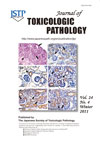14 巻, 1 号
選択された号の論文の14件中1~14を表示しています
- |<
- <
- 1
- >
- >|
Originals
-
原稿種別: Original
専門分野: None
2001 年14 巻1 号 p. 1
発行日: 2001年
公開日: 2001/06/01
PDF形式でダウンロード (849K) -
原稿種別: Original
専門分野: None
2001 年14 巻1 号 p. 9
発行日: 2001年
公開日: 2001/06/01
PDF形式でダウンロード (54K) -
原稿種別: Original
専門分野: None
2001 年14 巻1 号 p. 13
発行日: 2001年
公開日: 2001/06/01
PDF形式でダウンロード (494K) -
原稿種別: Original
専門分野: None
2001 年14 巻1 号 p. 19
発行日: 2001年
公開日: 2001/06/01
PDF形式でダウンロード (1809K) -
原稿種別: Original
専門分野: None
2001 年14 巻1 号 p. 29
発行日: 2001年
公開日: 2001/06/01
PDF形式でダウンロード (2423K) -
原稿種別: Original
専門分野: None
2001 年14 巻1 号 p. 37
発行日: 2001年
公開日: 2001/06/01
PDF形式でダウンロード (100K)
Short communication
-
原稿種別: Short Communication
専門分野: None
2001 年14 巻1 号 p. 45
発行日: 2001年
公開日: 2001/06/01
PDF形式でダウンロード (1408K)
Case Report
-
原稿種別: Case Report
専門分野: None
2001 年14 巻1 号 p. 51
発行日: 2001年
公開日: 2001/06/01
PDF形式でダウンロード (1665K)
Proceedings for Symposium “Toxic Changes of Endocrine Organs and Endocrine Disrupting Chemical” in the XVI Meeting of Japanese Society of Toxicologic Pathology
-
原稿種別: None
専門分野: None
2001 年14 巻1 号 p. 57
発行日: 2001年
公開日: 2001/06/01
PDF形式でダウンロード (15K) -
原稿種別: None
専門分野: None
2001 年14 巻1 号 p. 59
発行日: 2001年
公開日: 2001/06/01
PDF形式でダウンロード (205K) -
原稿種別: None
専門分野: None
2001 年14 巻1 号 p. 65
発行日: 2001年
公開日: 2001/06/01
PDF形式でダウンロード (194K) -
原稿種別: None
専門分野: None
2001 年14 巻1 号 p. 71
発行日: 2001年
公開日: 2001/06/01
PDF形式でダウンロード (98K) -
原稿種別: None
専門分野: None
2001 年14 巻1 号 p. 79
発行日: 2001年
公開日: 2001/06/01
PDF形式でダウンロード (51K) -
原稿種別: None
専門分野: None
2001 年14 巻1 号 p. 83
発行日: 2001年
公開日: 2001/06/01
PDF形式でダウンロード (60K)
- |<
- <
- 1
- >
- >|
